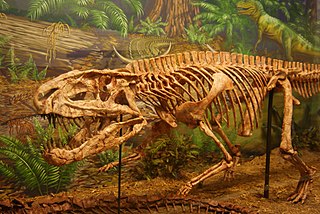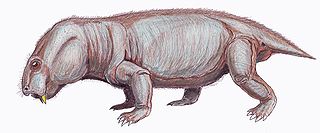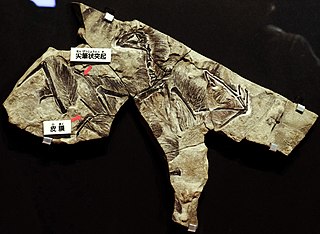
Dinocephalosaurus is a genus of long necked, aquatic protorosaur that inhabited the Triassic seas of China. The genus contains the type and only known species, D. orientalis, which was named by Chun Li in 2003. Unlike other long-necked protorosaurs, Dinocephalosaurus convergently evolved a long neck not through elongation of individual neck vertebrae, but through the addition of neck vertebrae that each had a moderate length. As indicated by phylogenetic analyses, it belonged in a separate lineage that also included at least its closest relative Pectodens, which was named the Dinocephalosauridae in 2021. Like tanystropheids, however, Dinocephalosaurus probably used its long neck to hunt, utilizing the fang-like teeth of its jaws to ensnare prey; proposals that it employed suction feeding have not been universally accepted. It was probably a marine animal by necessity, as suggested by the poorly-ossified and paddle-like limbs which would have prevented it from going ashore.

Postosuchus, meaning "Crocodile from Post", is an extinct genus of rauisuchid reptiles comprising two species, P. kirkpatricki and P. alisonae, that lived in what is now North America during the Late Triassic. Postosuchus is a member of the clade Pseudosuchia, the lineage of archosaurs that includes modern crocodilians. Its name refers to Post Quarry, a place in Texas where many fossils of the type species, P. kirkpatricki, were found. It was one of the apex predators of its area during the Triassic, larger than the small dinosaur predators of its time. It was a hunter which probably preyed on large bulky herbivores like dicynodonts and many other creatures smaller than itself.

A number of animals are capable of aerial locomotion, either by powered flight or by gliding. This trait has appeared by evolution many times, without any single common ancestor. Flight has evolved at least four times in separate animals: insects, pterosaurs, birds, and bats. Gliding has evolved on many more occasions. Usually the development is to aid canopy animals in getting from tree to tree, although there are other possibilities. Gliding, in particular, has evolved among rainforest animals, especially in the rainforests in Asia where the trees are tall and widely spaced. Several species of aquatic animals, and a few amphibians and reptiles have also evolved this gliding flight ability, typically as a means of evading predators.

Longisquama is a genus of extinct reptile. There is only one species, Longisquama insignis, known from a poorly preserved skeleton and several incomplete fossil impressions from the Middle to Late Triassic Madygen Formation in Kyrgyzstan. It is known from the type fossil specimen, slab and counterslab and five referred specimens of possible integumentary appendages. All specimens are in the collection of the Paleontological Institute of the Russian Academy of Sciences in Moscow.

Coelurosauravus is an extinct genus of gliding reptile, known from the Late Permian of Madagascar. Like other members of the family Weigeltisauridae, members of this genus possessed long, rod-like ossifications projecting outwards from the body. These bony rods were not extensions of the ribs but were instead a feature unique to weigeltisaurids. It is believed that during life, these structures formed folding wings used for gliding flight, similar to living gliding Draco lizards.

Sordes was a small pterosaur from the late Jurassic (Oxfordian/Kimmeridgian) Karabastau Svita of Kazakhstan.

Pistosaurus is an extinct genus of aquatic sauropterygian reptile closely related to plesiosaurs. Fossils have been found in France and Germany, and date to the Middle Triassic. It contains a single species, Pistosaurus longaevus. Pistosaurus is known as the oldest "subaquatic flying" reptile on earth.

Weigeltisaurus is an extinct genus of weigeltisaurid reptile from the Late Permian Kupferschiefer of Germany and Marl Slate of England. It has a single species, originally named as Palaechamaeleo jaekeli in 1930 and later assigned the name Weigeltisaurus jaekeli in 1939, when it was revealed that Palaeochamaeleo was a preoccupied name. A 1987 review by Evans and Haubold later lumped Weigeltisaurus jaekeli under Coelurosauravus as a second species of that genus. A 2015 reassessment of skull morphology study substantiated the validity of Weigeltisaurus and subsequent authors have used this genus. Like other Weigeltisaurids, they possessed long rod-like bones that radiated from the trunk that were likely used to support membranes used for gliding, similar to extant Draco lizards.

Xianglong is a genus of Cretaceous lizard discovered in the Zhuanchengzi, near Yizhou, Yixian, Liaoning Province of China. It is known from LPM 000666, a single complete skeleton with skin impressions. The specimen comes from the Barremian-age Lower Cretaceous Yixian Formation, near Yizhou. The most notable feature about Xianglong is its bizarre oversized ribs, eight on each side, which were attached to a membrane of body tissue and allowed the lizard to glide. While in its original description it was considered to acrodont lizard, with a cladistic analysis in the same study suggesting that it was grouped with iguanians such as agamines, chamaeleonids, and leiolepidines, it was later shown that this was due to misinterpretation of the crushed skull, and its affinities with other lizards remains uncertain.

Mecistotrachelos is an extinct genus of gliding reptile from the Late Triassic of Virginia. It is generally interpreted as an archosauromorph, distantly related to crocodylians and dinosaurs. The type and only known species is M. apeoros. This specific name translates to "soaring longest neck", in reference to its gliding habits and long neck. This superficially lizard-like animal was able to spread its lengthened ribs and glide on wing-like membranes. Mecistotrachelos had a much longer neck than other gliding reptiles of the Triassic such as Icarosaurus and Kuehneosaurus. It was probably an arboreal insectivore.

Dicynodontoides is a genus of small to medium-bodied, herbivorous, emydopoid dicynodonts from the Late Permian. The name Dicynodontoides references its “dicynodont-like” appearance due to the caniniform tusks featured by most members of this infraorder. Kingoria, a junior synonym, has been used more widely in the literature than the more obscure Dicynodontoides, which is similar-sounding to another distantly related genus of dicynodont, Dicynodon. Two species are recognized: D. recurvidens from South Africa, and D. nowacki from Tanzania.

Weigeltisauridae is a family of gliding neodiapsid reptiles that lived during the Late Permian, between 259.51 and 251.9 million years ago. Fossils of weigeltisaurids have been found in Madagascar, Germany, Great Britain, and Russia. They are characterized by long, hollow rod-shaped bones extending from the torso that probably supported wing-like membranes. Similar membranes are also found in several other extinct reptiles such as kuehneosaurids and Mecistotrachelos, as well as living gliding lizards, although each group evolved these structures independently.

Jesairosaurus is an extinct genus of early archosauromorph reptile known from the Illizi Province of Algeria. It is known from a single species, Jesairosaurus lehmani. Although a potential relative of the long-necked tanystropheids, this lightly-built reptile could instead be characterized by its relatively short neck as well as various skull features.
Kyrgyzsaurus is an extinct genus of drepanosaurid reptile known from the Triassic of southwestern Kyrgyzstan. It was discovered in the Madygen Formation.
The Madygen Formation is a Late Triassic (Carnian) geologic formation and Lagerstätte in the Batken and Osh Regions of western Kyrgyzstan, with minor outcrops in neighboring Tajikistan and Uzbekistan. The conglomerates, sandstones and mudstones of the 560 m (1,840 ft) thick formation were deposited in terrestrial lacustrine, alluvial, fluvial and deltaic environments.

Sharovipterygidae is a family of strange gliding archosauromorphs from the mid-Triassic of Eurasia, notable for their short forelimbs and long, wing-like hindlimbs, which supported membranes for gliding. They are represented by Sharovipteryx and Ozimek volans.

Tanystropheidae is an extinct family of archosauromorph reptiles that lived throughout the Triassic Period, often considered to be "protorosaurs". They are characterized by their long, stiff necks formed from elongated cervical vertebrae with very long cervical ribs. Members of the group include both terrestrial and aquatic forms. While some tanystropheids were small lizard-like animals, other tanystropheids such as Tanystropheus were large animals that had necks that were several meters long, longer than the rest of their bodies.

Yi is a genus of scansoriopterygid dinosaurs from the Late Jurassic of China. Its only species, Yi qi, is known from a single fossil specimen of an adult individual found in Middle or Late Jurassic Tiaojishan Formation of Hebei, China, approximately 159 million years ago. It was a small, possibly tree-dwelling (arboreal) animal. Like other scansoriopterygids, Yi possessed an unusual, elongated third finger, that appears to have helped to support a membranous gliding plane made of skin. The planes of Yi qi were also supported by a long, bony strut attached to the wrist. This modified wrist bone and membrane-based plane is unique among all known dinosaurs, and might have resulted in wings similar in appearance to those of bats.

Ozimek is a genus of sharovipterygid archosauromorph reptile, known from Late Triassic deposits in Poland and closely related to the Kyrgyzstani Sharovipteryx. It contains one species, O. volans, named in 2016 by Jerzy Dzik and Tomasz Sulej. Like Sharovipteryx, Ozimek had long, slender limbs with the hindlimbs longer than the forelimbs; the hindlimbs likely supported gliding membranes as fossilized in Sharovipteryx. Another unusual characteristic was the shoulder girdle, where the massive coracoids formed a shield-like structure covering the bottom of the shoulder region that would have limited mobility. In other respects, such as its long neck, it was a typical member of the non-natural grouping Protorosauria. Phylogenetic analysis has indicated that it, possibly along with Sharovipteryx, may have been an unusual member of the protorosaur group Tanystropheidae, although further study of its anatomy is needed to resolve its precise relationships.
Mbiresaurus is an extinct genus of basal sauropodomorph dinosaur from the Late Triassic (Carnian) Pebbly Arkose Formation of Zimbabwe. The genus contains a single species, Mbiresaurus raathi, known from a nearly complete skeleton. Mbiresaurus represents one of Africa’s earliest known definitive dinosaurs.






















